THE NATURAL ENVIRONMENT
Geography 101
ToC
EROSION
Wind
Waves
Coasts
Glaciers
Erosion by Wind
|
|
BOX 1 |
Wind can be a persistent erosive force in areas where bare rock and soil are exposed, like deserts and coastlines. Once again, sunlight provides the energy as differential heating and cooling of Earth's surface causes pressure differences that drive the winds.
Compared to other exogenic process, like crashing waves or cascading water, wind erosion and deposition, called aeolian processes, are weak, but over time the cumulative effect can produce some distinctive landforms and move huge amounts of material.
Erosion
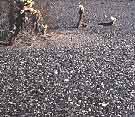 In
one of the simplest forms of erosion, wind simply blows away loose material,
a process called deflation. You
can see how the name came about: as loose material is blown away, the
land surface gradually lowers, or deflates. Of course, wind cannot carry large particles, so only the finest are
lifted into the air and removed. This leaves behind the larger sediments,
like gravel and pebbles. Over time this process can produce desert
pavement,
composed of fields of rocks as shown in the photo. Australia's Great
Stony Desert is an example of a large area of desert pavement.
In
one of the simplest forms of erosion, wind simply blows away loose material,
a process called deflation. You
can see how the name came about: as loose material is blown away, the
land surface gradually lowers, or deflates. Of course, wind cannot carry large particles, so only the finest are
lifted into the air and removed. This leaves behind the larger sediments,
like gravel and pebbles. Over time this process can produce desert
pavement,
composed of fields of rocks as shown in the photo. Australia's Great
Stony Desert is an example of a large area of desert pavement.
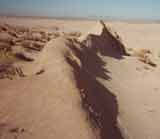 Wind
can also bounce material along the surface, analogous to bed load in
streams, causing abrasion. Wind abrasion
is nature's version of sandblasting. It produces smooth surfaces
related to the wind direction and is most effective close to the ground.
Next time you drive outside of Las Vegas,
Wind
can also bounce material along the surface, analogous to bed load in
streams, causing abrasion. Wind abrasion
is nature's version of sandblasting. It produces smooth surfaces
related to the wind direction and is most effective close to the ground.
Next time you drive outside of Las Vegas,  look
at the telephone poles. They have sheet metal wrapped around their bases
to protect against
destruction by wind abrasion. Continual sand blasting of rocks
can shape them into flat-sided ventifacts, rocks with
angular surfaces.
Yardangs are another wind erosion landform. These
resistant rock formations become sculpted over time into
long ridges parallel to the wind direction.
look
at the telephone poles. They have sheet metal wrapped around their bases
to protect against
destruction by wind abrasion. Continual sand blasting of rocks
can shape them into flat-sided ventifacts, rocks with
angular surfaces.
Yardangs are another wind erosion landform. These
resistant rock formations become sculpted over time into
long ridges parallel to the wind direction.
Transportation
 Although
weaker than other exogenic agents, wind is capable of moving the tiniest
mineral particles enormous distances. Fine dust picked up in the interior
deserts of China,
for example, travels eastward on the high-altitude westerly winds settling
out over an enormous swath of the North Pacific Ocean, including the
Hawaiian
Islands.
The
study
of
so-called Asian dust in Hawaiian soil has revealed much
about past climates and present day soil fertility.
Although
weaker than other exogenic agents, wind is capable of moving the tiniest
mineral particles enormous distances. Fine dust picked up in the interior
deserts of China,
for example, travels eastward on the high-altitude westerly winds settling
out over an enormous swath of the North Pacific Ocean, including the
Hawaiian
Islands.
The
study
of
so-called Asian dust in Hawaiian soil has revealed much
about past climates and present day soil fertility.
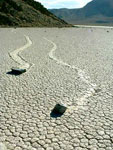 Of
course, no Hollywood movie set in a desert would be complete without
the classic sand storm scene. Dust and sand storms do
occur, of course, blasting fine sand into every conceivable crack and
crevice.
Lifting
large mineral grains requires strong winds, and when they subside, the
sand falls quickly back to Earth.
Of
course, no Hollywood movie set in a desert would be complete without
the classic sand storm scene. Dust and sand storms do
occur, of course, blasting fine sand into every conceivable crack and
crevice.
Lifting
large mineral grains requires strong winds, and when they subside, the
sand falls quickly back to Earth.
Wind also rolls and bounces particles along the surface. In fact, this accounts for about 80% of all transportation by wind. An interesting artifact of surface motion caused by wind occurs in Death Valley, California's sailing rocks. After decades of mystery and speculation, their motion was finally photographed in 2014. Apparently, a rare combination of rain, freezing, rapid thaw to break up the ice and subsequent wind causes broken ice sheets to push the rocks across the slippery mud in parallel tracks, leaving a shallow trail as they go.
Deposition
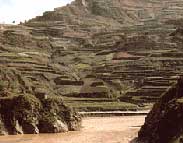 Transportation
by wind sorts material by size. The smallest grains (clay) may be blown
far away and spread over a large area, as
noted above in the case of Asian dust in Hawai'i. Somewhat larger sizes
(silt) may form deposits on the edge of deserts called loess.
The enormous loess deposits on the edge of China's Gobi desert provide
the Huang He's (Yellow River) heavy sediment load.
Transportation
by wind sorts material by size. The smallest grains (clay) may be blown
far away and spread over a large area, as
noted above in the case of Asian dust in Hawai'i. Somewhat larger sizes
(silt) may form deposits on the edge of deserts called loess.
The enormous loess deposits on the edge of China's Gobi desert provide
the Huang He's (Yellow River) heavy sediment load.
Loess has a curiously strong structure. It is easily carved and will retain vertical walls without collapsing. In China, many families live in loess caves, dug into the cliffs and hills along the Huang He.
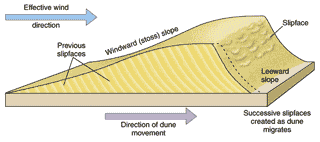 The larger
grains of sand travel by bouncing along the surface and collect into
wind's most recognizable creations: sand dunes. The dune itself travels
in the direction of the wind. Sand bounces up the gentle slope of the
windward face, then cascades down the steeper, leeward slipface.
This steady rolling of sand grains continually churns the dune, so
that
no grain remains unexposed for long.
The larger
grains of sand travel by bouncing along the surface and collect into
wind's most recognizable creations: sand dunes. The dune itself travels
in the direction of the wind. Sand bounces up the gentle slope of the
windward face, then cascades down the steeper, leeward slipface.
This steady rolling of sand grains continually churns the dune, so
that
no grain remains unexposed for long.
 In
this way, dunes can migrate outside the area of true deserts. Occasionally,
they may move directly
over a settlement, burying it under a mountain of sand. Many, many
archeological ruins have been excavated from beneath the sand, including
Egypt's Sphinx.
In
this way, dunes can migrate outside the area of true deserts. Occasionally,
they may move directly
over a settlement, burying it under a mountain of sand. Many, many
archeological ruins have been excavated from beneath the sand, including
Egypt's Sphinx.
 Dunes take many forms, depending on wind direction
and characteristics of the surface they move across.
Dunes take many forms, depending on wind direction
and characteristics of the surface they move across.
When the wind blows from a relatively constant direction, transverse dunes form perpendicular to the wind direction. These are common at shorelines with steady onshore winds.
If not enough sand is available to create a continuous transverse dune, smaller crescent-shaped barchan dunes form. The smaller ends of the dunes, the horns, move faster than the main body and thus point downwind.
If winds frequently shift, but still come from the same general direction, longitudinal dunes develop running parallel to the average wind direction. Longitudinal dunes cover vast areas of some desert regions such as central Australia and the Arabian Peninsula.
Finally, when winds characteristically blow from many different directions, sand piles into a mountain called a star dune. These tallest of all dunes may be 200 meters high.
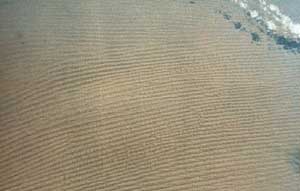 |
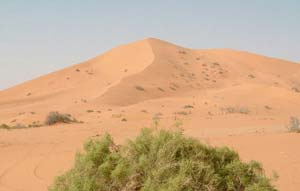 |
Longitudinal dunes, Arabian Peninsula |
Star Dune, American southwest |
Hawai'i
Although not as important as running water or waves, wind also shapes landforms in the Hawaiian Islands. The Garden of the Gods on Lanai, for example, is filled with wind-sculpted ventifacts, including the one in the image above under Erosion. Long, parallel ridges of longitudinal dunes have been swept inland by the trade winds at the west end of Moloka'i and southeast Ni'ihau. Many other coastal areas have accumulated transverse dunes parallel to beaches and perpendicular to the trade winds where vegetation anchors the sand and keeps the dune from migrating inland.

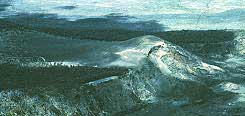 Wind
also produces asymmetry in volcanic cinder cones as fountaining lava
blows downwind to form a tail. Fountaining from Kilauea
Iki (shown at left) in 1959 produced a long cinder tail extending to
the southwest (middle left in photo at right),
which today provides the setting
for Desolation Trail in Hawai'i Volcanoes National Park.
Wind
also produces asymmetry in volcanic cinder cones as fountaining lava
blows downwind to form a tail. Fountaining from Kilauea
Iki (shown at left) in 1959 produced a long cinder tail extending to
the southwest (middle left in photo at right),
which today provides the setting
for Desolation Trail in Hawai'i Volcanoes National Park.
The observation that cinder cone tails usually point west or southwest, even from vents tens or hundreds of thousands of years old, provides evidence that the northeast trade winds have prevailed in Hawai'i for a long, long time.